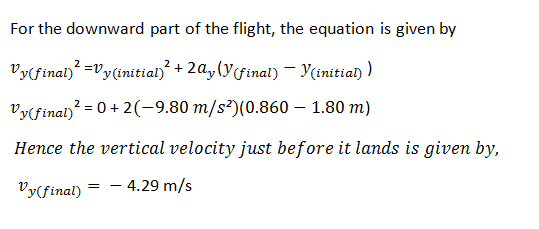
College Physics
11th Edition
ISBN: 9781305952300
Author: Raymond A. Serway, Chris Vuille
Publisher: Cengage Learning
expand_more
expand_more
format_list_bulleted
Concept explainers
Topic Video
Question

Transcribed Image Text:hen he leaves the floor. It reaches a maximum height of 1.80 m above the floor and is at elevation 0.860 m when he touches down again.
(a) Determine his time of flight (his "hang time").
(b) Determine his horizontal velocity at the instant of takeoff.
m/s
(c) Determine his vertical velocity at the instant of takeoff.
m/s
Expert Solution
arrow_forward
Step 1
“Since you have posted a question with multiple sub-parts, we will solve first three subparts
for you. To get remaining sub-part solved please repost the complete question and
mention the sub-parts to be solved.”.

arrow_forward
Step 2


Step by stepSolved in 4 steps with 6 images

Knowledge Booster
Learn more about
Need a deep-dive on the concept behind this application? Look no further. Learn more about this topic, physics and related others by exploring similar questions and additional content below.Similar questions
- It is observed that the skier leaves the ramp A at an angle A = 27° with the horizontal. (Figure 1) Figure 1 of 1 4m 100 m If he strikes the ground at B, determine his initial speed VA Express your answer with the appropriate units. μA ? m VA = S Submit Previous Answers Request Answer X Incorrect; Try Again; 5 attempts remaining Part B Determine the time of flight t AB. Express your answer with the appropriate units. μA t AB = Value Units Value B) ?arrow_forwardGiven: X - coordinate: x = -5.00sinwt, where w is constant, xis meters, andt is seconds y - coordinate: y = 4.00 - 5.00coswt, where w is constant, y in meters, andt seconds What is the expression for velocity vector? O A. 5w(coswti+sinwi) O B. 5w(-coswtî+sinwî) O C. 5w(coswti-sinwj) O D. 5w(-coswti-sinwî)arrow_forwardOption 2 1. The body, vertically down with an initial speed of 5 m/s, in the last 2 s of the fall, the path went twice as much as in the previous 2 s. Determine the time and height of the fall.arrow_forward
- A ball is thrown upward from the ground with velocity vi= 14 m/s and reaches height of h above the ground before falling back down. Take the upward direction to be positive. Refer to the figure. Neglect Air resistance. The acceleration in m/s to the ball when it is in the air is -9.8 m/s. The velocity of the ball in meters sped second, when it reaches the top of its trajectory is 0 m/s. Enter an expression for the maximum height, h, the ball reached in terms of vf, vi, and a. The value of h in meters is 10 m. Enter an expression for the time it takes for the ball to travel from the ground to the top, delta t, in terms of vi, vf, and a. The value of delta t in seconds is 10s. The total displacement in meters, of the ball going through its entire motion: reveling from the ground to the tio and then falling back to the ground is 0m. Enter an expression for the total time of flight of the ball: the time from when it is launched to when it lands back in the ground. Express this in terms of…arrow_forwardA ball is thrown vertically upwards from the ground at a speed of 15.0 m/s. At what time/s will it be at a height of 4.00 m (in seconds) hint: there will be two answers. Type both in the box (in seconds)arrow_forwardThe height above the ground of a drone is given by h = 3.50 t³, where h is in meters and t is in seconds. Calculate at t = 2.50 s (a) the height of the drone above the ground and (b) the velocity of the drone. At this time (t = 2.50 s) the drone releases a package (c) how long does it take the package to reach the ground? Include a complete diagram of the situation.arrow_forward
arrow_back_ios
arrow_forward_ios
Recommended textbooks for you
 College PhysicsPhysicsISBN:9781305952300Author:Raymond A. Serway, Chris VuillePublisher:Cengage Learning
College PhysicsPhysicsISBN:9781305952300Author:Raymond A. Serway, Chris VuillePublisher:Cengage Learning University Physics (14th Edition)PhysicsISBN:9780133969290Author:Hugh D. Young, Roger A. FreedmanPublisher:PEARSON
University Physics (14th Edition)PhysicsISBN:9780133969290Author:Hugh D. Young, Roger A. FreedmanPublisher:PEARSON Introduction To Quantum MechanicsPhysicsISBN:9781107189638Author:Griffiths, David J., Schroeter, Darrell F.Publisher:Cambridge University Press
Introduction To Quantum MechanicsPhysicsISBN:9781107189638Author:Griffiths, David J., Schroeter, Darrell F.Publisher:Cambridge University Press Physics for Scientists and EngineersPhysicsISBN:9781337553278Author:Raymond A. Serway, John W. JewettPublisher:Cengage Learning
Physics for Scientists and EngineersPhysicsISBN:9781337553278Author:Raymond A. Serway, John W. JewettPublisher:Cengage Learning Lecture- Tutorials for Introductory AstronomyPhysicsISBN:9780321820464Author:Edward E. Prather, Tim P. Slater, Jeff P. Adams, Gina BrissendenPublisher:Addison-Wesley
Lecture- Tutorials for Introductory AstronomyPhysicsISBN:9780321820464Author:Edward E. Prather, Tim P. Slater, Jeff P. Adams, Gina BrissendenPublisher:Addison-Wesley College Physics: A Strategic Approach (4th Editio...PhysicsISBN:9780134609034Author:Randall D. Knight (Professor Emeritus), Brian Jones, Stuart FieldPublisher:PEARSON
College Physics: A Strategic Approach (4th Editio...PhysicsISBN:9780134609034Author:Randall D. Knight (Professor Emeritus), Brian Jones, Stuart FieldPublisher:PEARSON

College Physics
Physics
ISBN:9781305952300
Author:Raymond A. Serway, Chris Vuille
Publisher:Cengage Learning

University Physics (14th Edition)
Physics
ISBN:9780133969290
Author:Hugh D. Young, Roger A. Freedman
Publisher:PEARSON

Introduction To Quantum Mechanics
Physics
ISBN:9781107189638
Author:Griffiths, David J., Schroeter, Darrell F.
Publisher:Cambridge University Press

Physics for Scientists and Engineers
Physics
ISBN:9781337553278
Author:Raymond A. Serway, John W. Jewett
Publisher:Cengage Learning

Lecture- Tutorials for Introductory Astronomy
Physics
ISBN:9780321820464
Author:Edward E. Prather, Tim P. Slater, Jeff P. Adams, Gina Brissenden
Publisher:Addison-Wesley

College Physics: A Strategic Approach (4th Editio...
Physics
ISBN:9780134609034
Author:Randall D. Knight (Professor Emeritus), Brian Jones, Stuart Field
Publisher:PEARSON